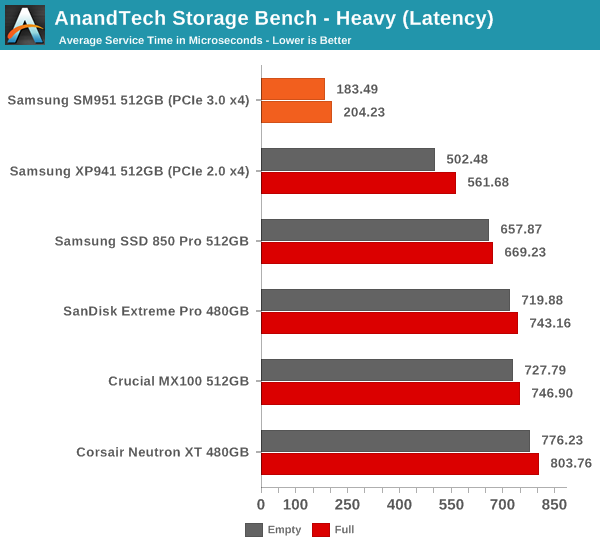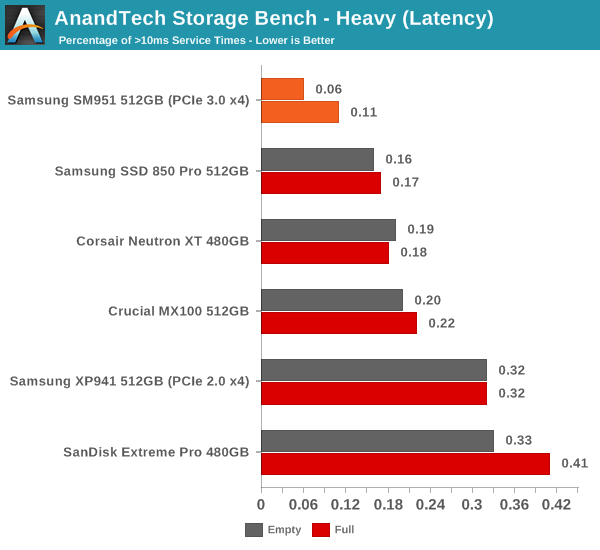Samsung SM951 (512GB) PCIe SSD Review
by Kristian Vättö on February 24, 2015 8:00 AM ESTAnandTech Storage Bench - Heavy
While The Destroyer focuses on sustained and worst-case performance by hammering the drive with nearly 1TB worth of writes, the Heavy trace provides a more typical enthusiast and power user workload. By writing less to the drive, the Heavy trace doesn't drive the SSD into steady-state and thus the trace gives us a good idea of peak performance combined with some basic garbage collection routines.
| AnandTech Storage Bench - Heavy | ||||||||||||
| Workload | Description | Applications Used | ||||||||||
| Photo Editing | Import images, edit, export | Adobe Photoshop | ||||||||||
| Gaming | Pllay games, load levels | Starcraft II, World of Warcraft | ||||||||||
| Content Creation | HTML editing | Dreamweaver | ||||||||||
| General Productivity | Browse the web, manage local email, document creation, application install, virus/malware scan | Chrome, IE10, Outlook, Windows 8, AxCrypt, uTorrent, AdAware | ||||||||||
| Application Development | Compile Chromium | Visual Studio 2008 | ||||||||||
The Heavy trace drops virtualization from the equation and goes a bit lighter on photo editing and gaming, making it more relevant to the majority of end-users.
| AnandTech Storage Bench - Heavy - Specs | ||||||||||||
| Reads | 2.17 million | |||||||||||
| Writes | 1.78 million | |||||||||||
| Total IO Operations | 3.99 million | |||||||||||
| Total GB Read | 48.63 GB | |||||||||||
| Total GB Written | 106.32 GB | |||||||||||
| Average Queue Depth | ~4.6 | |||||||||||
| Focus | Peak IO, basic GC routines | |||||||||||
The Heavy trace is actually more write-centric than The Destroyer is. A part of that is explained by the lack of virtualization because operating systems tend to be read-intensive, be that a local or virtual system. The total number of IOs is less than 10% of The Destroyer's IOs, so the Heavy trace is much easier for the drive and doesn't even overwrite the drive once.
| AnandTech Storage Bench - Heavy - IO Breakdown | |||||||||||
| IO Size | <4KB | 4KB | 8KB | 16KB | 32KB | 64KB | 128KB | ||||
| % of Total | 7.8% | 29.2% | 3.5% | 10.3% | 10.8% | 4.1% | 21.7% | ||||
The Heavy trace has more focus on 16KB and 32KB IO sizes, but more than half of the IOs are still either 4KB or 128KB. About 43% of the IOs are sequential with the rest being slightly more full random than pseudo-random.
| AnandTech Storage Bench - Heavy - QD Breakdown | ||||||||||||
| Queue Depth | 1 | 2 | 3 | 4-5 | 6-10 | 11-20 | 21-32 | >32 | ||||
| % of Total | 63.5% | 10.4% | 5.1% | 5.0% | 6.4% | 6.0% | 3.2% | 0.3% | ||||
In terms of queue depths the Heavy trace is even more focused on very low queue depths with three fourths happening at queue depth of one or two.
I'm reporting the same performance metrics as in The Destroyer benchmark, but I'm running the drive in both empty and full states. Some manufacturers tend to focus intensively on peak performance on an empty drive, but in reality the drive will always contain some data. Testing the drive in full state gives us valuable information whether the drive loses performance once it's filled with data.

The SM951 performs even strongly in our Heavy trace and presents nearly 100% improvement in data rate over the XP941. In full state the SM951 loses a bit of its performance, but that's normal and the drop isn't any bigger than in other drives. Despite the lack of NVMe, it's starting to be clear that the SM951 is significantly faster than its predecessor and any SATA 6Gbps SSD.

The average latency is also cut in less than half, which is actually a more substantial improvement than going from a SATA 6Gbps drive to the XP941.

The share of high latency IOs is also the lowest with only 0.06% of the IOs having a higher than 10ms service time.










128 Comments
View All Comments
Kristian Vättö - Wednesday, February 25, 2015 - link
I didn't test any OCZ drives for this review because the Vector 180 NDA is due in a couple of days, so stay tuned.IlikeSSD - Thursday, February 26, 2015 - link
Vertex 460A is good enough to show the difference (maybe even Arc))Shadowmaster625 - Wednesday, February 25, 2015 - link
You should clip on a simple heatsink and run the tests again.squatsh - Wednesday, February 25, 2015 - link
Based on the orientation of the drive in it's M2 slot. (Ie is the controller facing up or down) Can it be made clear if we could just put a small thermal pad and one of those tiny heatsinks (like you can get for VRMs) on the controller (assuming that is what is overheating) in order to stop the thermal throttling on desktops and laptops with enough space.Luke212 - Wednesday, February 25, 2015 - link
what happened to the Intel P3500? It's been a year and nothing.Mikemk - Wednesday, February 25, 2015 - link
Comment 100Sorry, couldn't resist
awall13 - Thursday, February 26, 2015 - link
Thanks for the great review. I like the changes in how the data is presented. One idea: In the performance consistency section, the steady-state performance could be presented with a single two-color bar per drive, with the full bar representing the average performance, and the shorter bar representing the average - 1 standard deviation. I'd still keep the second chart showing the standard deviation by itself, perhaps. Just a thought.gseguin - Thursday, February 26, 2015 - link
Performance performance performance. Ok, I get it, its fast and hard to find.Since we saw many issues crop up with the predecessors, with eventual fixes by Samsung, how much confidence is there in the drive itself from Anandtech... You know the controllers, you know the memory, you've covered different company's testing methodologies, how much confidence do you have in this product, and why is that absent from the introduction and final thoughts?
Kristian Vättö - Thursday, February 26, 2015 - link
All Samsung's issues have been related to SSD with planar TLC NAND (i.e. 840 & 840 EVO). There is absolutely no reason to believe that the SM951 shares the issues because it's based on MLC NAND and Samsung's MLC NAND based SSDs have been flawless (830 & 840 Pro).kgh00007 - Saturday, February 28, 2015 - link
Hey, nice article. I like the new SSD test suite. Is there any way to add a long term read consistency test, or any sort of read consistency test in light of the Samsung 840 EVO issues?I'm an 840 EVO user with drops in read speed to below 50Mb/s. In fact I have never gotten the advertised 500MB/s read speeds on any SSD I own. Is that because I am using them as the boot drive?
Do you test with the SSD as a second drive in the system? So taking out the overhead of the OS running on the drive as well as the test suite?
Cheers, keep up the good work, I've been learning from this site for a long time....